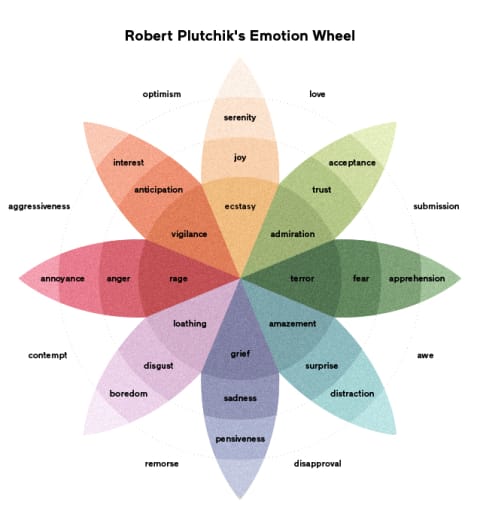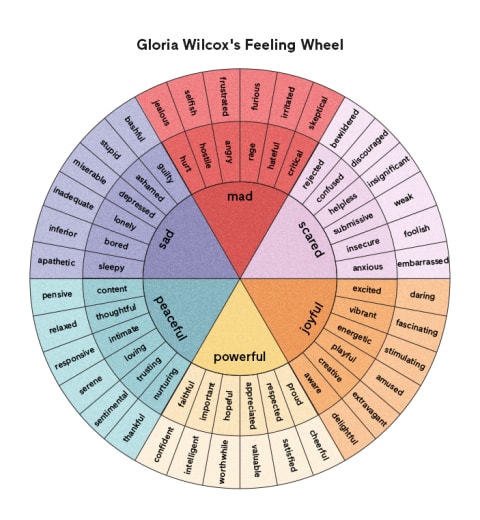“Primary emotions are basic emotions that humans are born with that have been wired into our brains,” Espinoza says. “Along the outer edges of the emotion wheel, you’ll find low-intensity emotions such as acceptance, distraction, boredom, and so on. As you move toward the center, the color on the emotion wheel deepens and milder emotions become your basic emotions.” Psychologist Robert Plutchik, Ph.D., created one of the most popular versions of the emotion wheel, a flower-shaped diagram to visually illustrate our emotions and their various, adjacent relationships to each other. He believed that while humans have the capacity to experience over 34,000 unique emotions, there are eight primary, primordial emotions that serve as the foundation for other feelings, in all of their degrees and intensities, to exist and take place. To make it easier to recognize and describe our feelings, the wheel was gridded out in a way to demonstrate emotions in its various states, dyads, constructs, combinations, similarities, and dissimilarities. Instead of casting emotions aside as too mysterious or vague for our interpretation, he wanted to understand their biological basis and the connections between them. Through his psychoevolutionary approach, he asserted that our basic emotions play a role in human survival and can be patterned out to reveal common emotional elements that we all go through. According to research by psychologist David L. Robinson, it’s important to respond to your emotions authentically to connect to your truest self. If the primary emotion is not felt, you can lose connection to that feeling and instead identify with the secondary emotion, which almost functions as a red herring to what’s really happening. On the emotion wheel, the primary emotions are also grouped together in the center based on likeness and placed in direct opposition to its actual counter on the wheel to form its polar opposite. “Emotions exist along a spectrum of intensity,” psychotherapist and trauma coach Dylesia Hampton Barner, LCSW, explains. “Polar opposite emotions serve the purpose of capturing the emotional states leading to the most heightened intensity within a particular emotion and provide guidance for what can happen when unwanted emotions go unaddressed. For instance, annoyance can become rage.” Below are the descriptions, causes, and reactions of the foundational, primary emotions used in Robinson’s emotional experience research: “Notice what you are feeling. Allow yourself to feel your feelings. Notice the physical sensations in your body (i.e., pressure on chest, stomachache, headache). Then identify whether you are experiencing a primary or secondary emotion,” she advises. Start with the basic emotions and then keep going until you find the word that closely describes your emotional experience. There isn’t really a right or wrong way to use the wheel. What matters more is having a vocabulary that you can lean on when you need to add more detail to your emotions beyond the basic feeling of just feeling good or bad and not knowing why. By attuning to your body and paying attention to the external and internal factors that may be contributing to your feelings, this will help you slow down and co-regulate. “People use the emotion wheel to get in touch with their feelings by helping them visualize their emotions and helping them understand which combinations of emotions created a certain outcome or behavior. It helps individuals become more self-aware…Individuals can also benefit from seeing the opposite emotion that can help strengthen their emotional intelligence,” Espinoza explains. To understand emotions and see how they play an important role in our life, it’s essential to break down their various components. Barner shares a quick primer of what these components look like in action: However, Barner says there may be atypical action responses referred to as trauma responses (flight, fight, freeze, or fawn), which are reactionary behaviors to stress, which can be adopted by those who have experienced abuse and/or threat. Thus, it can trigger an unconscious fight-or-flight response for trauma survivors if they find themselves in similar situations. This is important to note because that means they won’t be able to process certain emotions clearly if it’s been linked to trauma in the past. “The four trauma responses may be expressed even in positive scenarios due to suspicion of danger many trauma survivors experience at all times,” she adds. “Because our emotional expressions and how we subsequently act is linked to how we appraise circumstances, survivors of trauma are more likely to interpret situations based on their traumatic experiences in an effort to protect themselves,” Barner adds. “We can look at the imbalances in our jobs, relationships, and environments from a unique perspective. Instead of thinking there is something ‘wrong’ with us, we can ask, ‘What emotional needs are not being met?’” life coach William Barker writes at mbg. “Emotional needs are feelings or conditions we need to feel happy, fulfilled, or at peace. Without them, we may feel frustrated, hurt, or dissatisfied. Some examples of emotional needs might include feeling appreciated, feeling accomplished, feeling safe, or feeling part of a community. As humans, we seek emotional nourishment as much as food and water. It is your birthright to be emotionally nourished,” he says. Other situations where it can be helpful is “where there is frequent misunderstanding or miscommunication between partners, when they’re having a hard time understanding the emotions and behaviors of their friends or family, or when they want to become more assertive and expressive of their emotions and needs,” she says. By getting in touch with your real needs and becoming comfortable with your emotions, the good and the bad, it will feel less overwhelming over time. To do this, Barner recommends paying attention to the factors that led to your emotional shift to identify and articulate those emotions. Over time, your response time will improve as you feel safer with your inner world. If you’re finding it’s hard to move past certain blocks on your own, Barner suggests approaching the wheel from a trauma-informed perspective to look out for any unknowns that may be preventing you from fully exploring your emotions. “With my clients, I guide them in exploring where else they’ve felt that way in their life, which provides context to identify the traumatic root of unwanted emotional states and atypical action tendencies.” If there’s a history of trauma, it can be helpful to work with a trained professional for help through this process. Espinoza goes on to recommend using “I” statements to convey to the other person what you are feeling. “I feel ________ when you ________. This will help convey effective communication. Make sure there is proper eye contact and neutral body language to avoid misunderstandings.” Take it from Espinoza: “It is imperative to name our emotions and know what we are feeling in order to prevent an intensification of emotions, which can result when we don’t deal with or confront our emotions. The emotion wheel is a helpful tool that helps one identify their feelings and become comfortable in sitting and feeling their emotions.”





